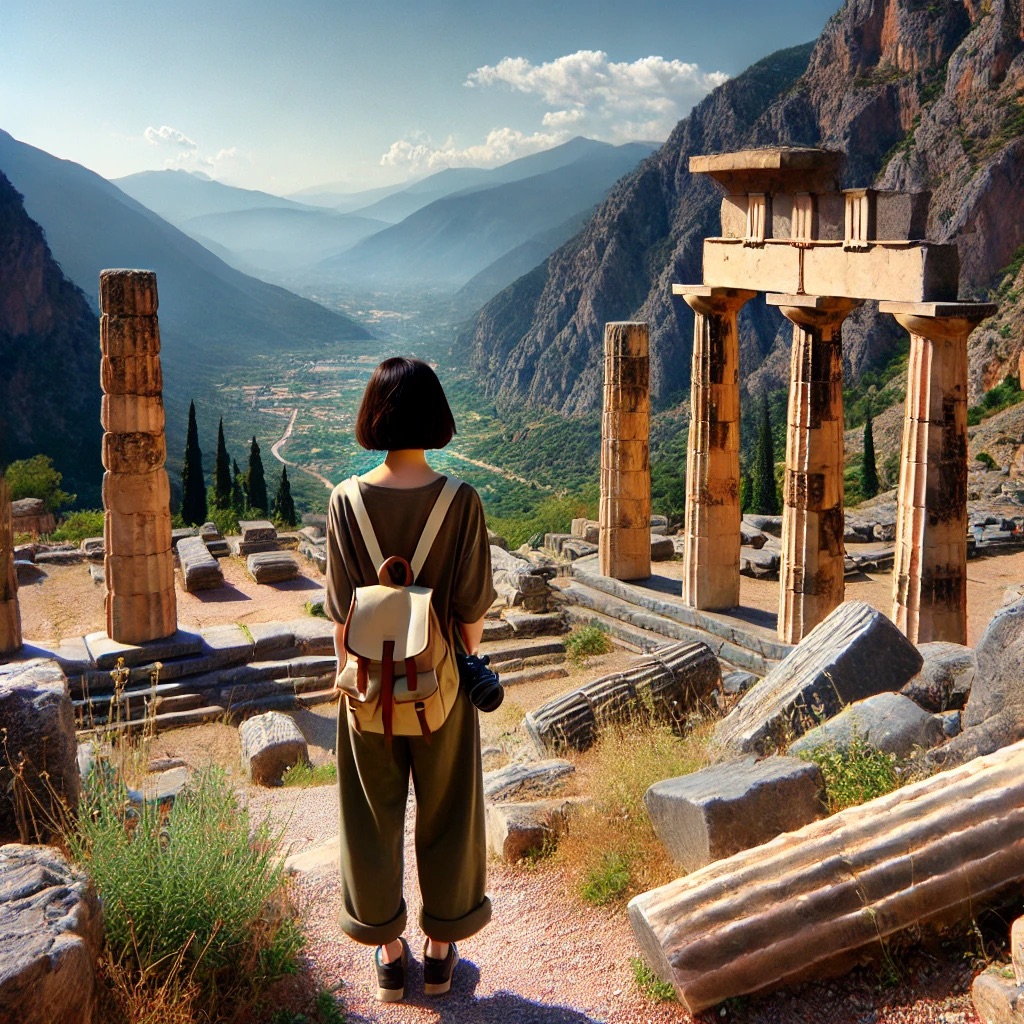ChatGPT:
Delphi, Greece, is one of the most significant archaeological sites in the world, renowned for its rich history and cultural significance in ancient Greece. Located on the slopes of Mount Parnassus, about 180 kilometers northwest of Athens, Delphi was considered the center of the world in ancient Greek mythology. According to legend, it was here that the two eagles sent by Zeus from opposite ends of the earth met, marking the “navel of the world” (the Omphalos).
The site is best known for the Oracle of Delphi, where the priestess Pythia would deliver prophecies inspired by the god Apollo. Pilgrims from all over the Greek world and beyond would come to consult the Oracle, seeking guidance on various matters from personal affairs to decisions of state.
Delphi was also home to the Pythian Games, one of the four Panhellenic Games of ancient Greece, second in importance only to the Olympics. These games, held every four years, featured athletic and musical competitions and were held in honor of Apollo.
Today, visitors to Delphi can explore its well-preserved ruins, including the Temple of Apollo, the ancient theater, the stadium, and the Tholos of Delphi, a circular building with striking columns. The Delphi Archaeological Museum nearby houses a vast collection of artifacts uncovered at the site, including the famous Charioteer of Delphi, a bronze statue that is a masterpiece of ancient Greek art.
Delphi’s dramatic setting, with its panoramic views of the surrounding mountains and the valley of Phocis, adds to its allure, making it a popular destination for both history enthusiasts and those seeking to experience the spiritual atmosphere of this ancient sanctuary.
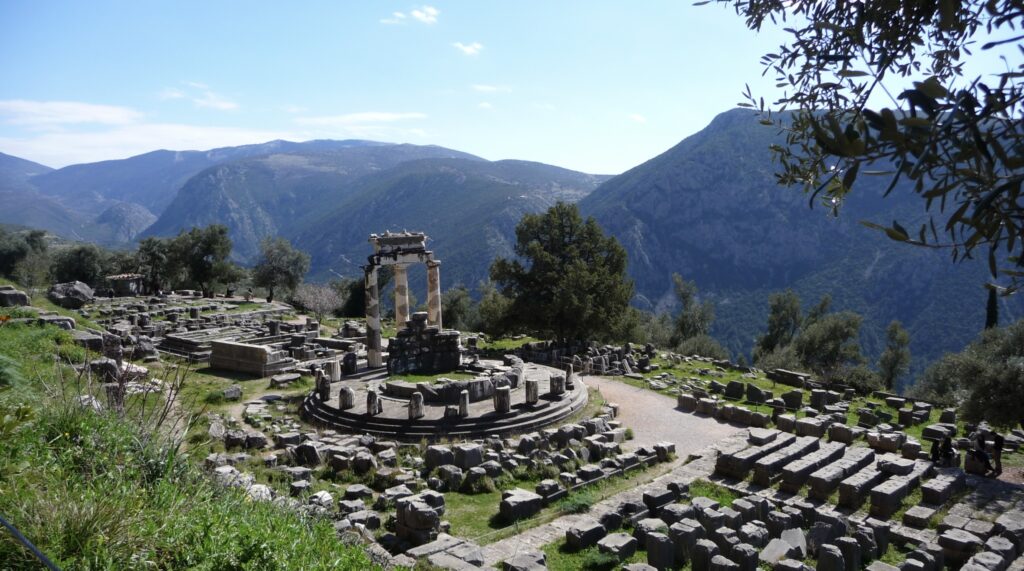
Delphi’s origin and history are deeply intertwined with ancient Greek mythology, religion, and politics. Here’s a detailed look at its development:
Mythological Origins
The origins of Delphi are rooted in Greek mythology. According to legend, the site was originally sacred to Gaia, the Earth goddess, and was guarded by her serpent offspring, Python. Apollo, the god of prophecy, music, and the sun, later came to Delphi, slayed Python, and established his own oracle there. To purify himself after this act, Apollo is said to have founded the Pythian Games, named after the slain serpent, and established the priesthood that would serve the oracle.
The site became known as the “navel of the world” or the Omphalos, symbolized by a stone that was believed to mark the center of the earth. This legend underscored Delphi’s significance as a focal point of the ancient Greek world.
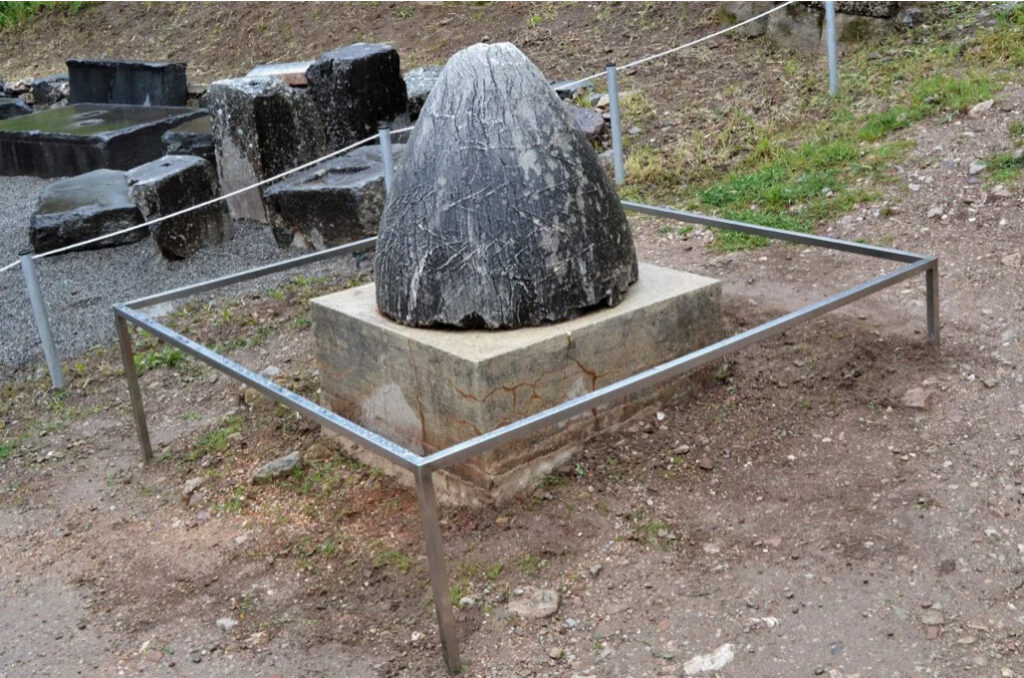
Early History and Development
Delphi’s development as a religious and cultural center began in the Mycenaean period (around 1600–1100 BCE), during which the site was already considered sacred. However, it wasn’t until the 8th century BCE that Delphi began to gain prominence as a major sanctuary of Apollo. During this period, the oracle of Delphi became increasingly important, attracting visitors from across Greece and beyond who sought divine guidance.
The Rise of the Oracle and the Sanctuary
By the 6th century BCE, Delphi had grown into a major religious and political center. The Oracle of Delphi, served by the priestess Pythia, became the most esteemed oracle in Greece. The Pythia would enter a trance, induced by vapors from a chasm in the earth (according to some sources), and deliver cryptic prophecies that were interpreted by priests.
Delphi’s influence extended far beyond Greece. Leaders from foreign lands, including Lydia and Persia, sent delegations to consult the oracle, and their offerings contributed to the wealth and splendor of the sanctuary.
To accommodate the growing number of visitors and to house the offerings, a complex of temples, treasuries, and other buildings was constructed on the site. The Temple of Apollo, built in the 4th century BCE on the ruins of an earlier structure, became the centerpiece of the sanctuary. The sacred way, a path leading up to the temple, was lined with statues, monuments, and treasuries, donated by various Greek city-states as offerings to Apollo.
The Pythian Games and Cultural Influence
The Pythian Games, established in the 6th century BCE, were held every four years in honor of Apollo. These games included athletic competitions, similar to those of the Olympic Games, as well as musical and artistic contests. The games attracted participants and spectators from all over the Greek world, further enhancing Delphi’s status as a cultural hub.
Political Influence and the Delphic Amphictyony
Delphi also played a significant role in Greek politics through the Delphic Amphictyony, a religious association of neighboring tribes and city-states that managed the sanctuary and organized the Pythian Games. The Amphictyony acted as a governing body, resolving disputes among its members and making decisions that affected the wider Greek world.
Decline and Roman Influence
Delphi’s importance began to wane in the 4th century BCE as the political landscape of Greece changed, and new powers like Macedonia rose to prominence. However, Delphi remained an influential religious center.
When the Romans conquered Greece in the 2nd century BCE, they were awed by Delphi’s prestige and continued to support the sanctuary. Roman emperors, including Nero and Hadrian, visited Delphi and made contributions to the site. Despite this, the oracle’s influence gradually diminished, especially as Christianity spread across the Roman Empire.
The End of the Oracle and Delphi’s Legacy
The oracle of Delphi continued to function into the late Roman period, but by the 4th century CE, with the rise of Christianity and the decline of pagan worship, its influence had significantly diminished. In 393 CE, the Roman Emperor Theodosius I, who was a Christian, ordered the closure of all pagan temples, marking the official end of the oracle.
Over the centuries, Delphi fell into ruins and was eventually forgotten until its rediscovery in the 19th century during archaeological excavations. Today, Delphi is recognized as a UNESCO World Heritage Site and is celebrated as one of the most important cultural and historical sites of ancient Greece, offering profound insights into the religious, political, and social life of the ancient world.
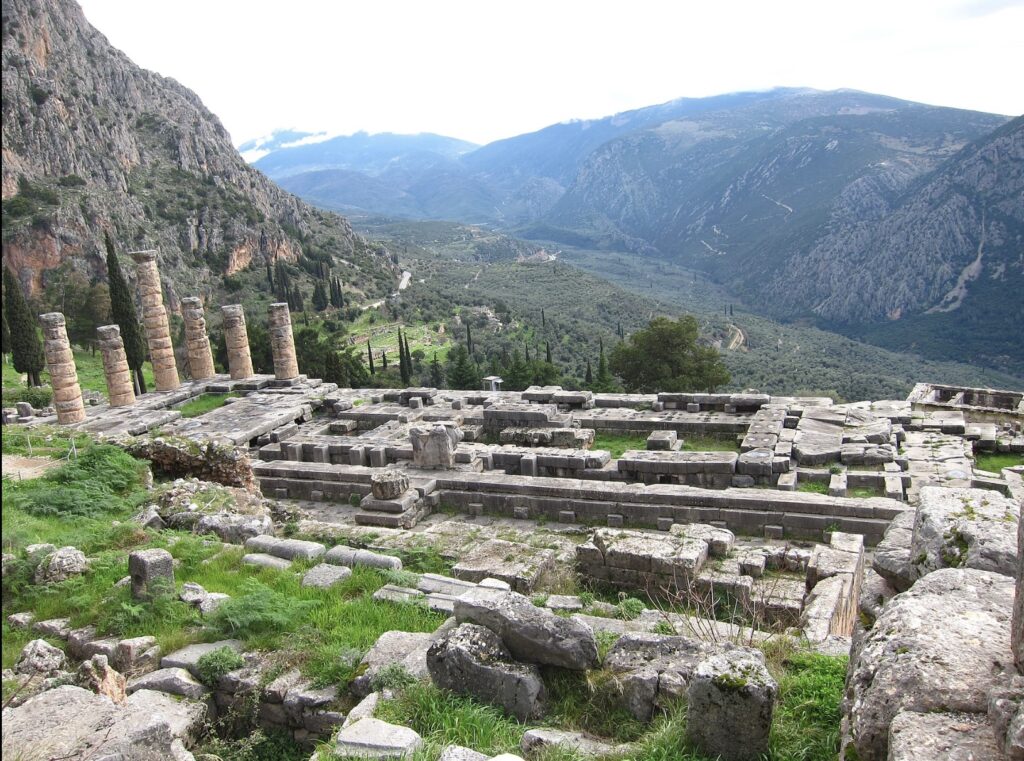
Delphi is home to a number of significant historical monuments and attractions, many of which are central to understanding the site’s importance in ancient Greek culture. Here’s a list of the most notable ones:
1. Temple of Apollo
- The centerpiece of the Delphi site, this temple was where the Oracle of Delphi, the priestess Pythia, delivered her prophecies. The temple was rebuilt several times, with the current ruins dating back to the 4th century BCE.
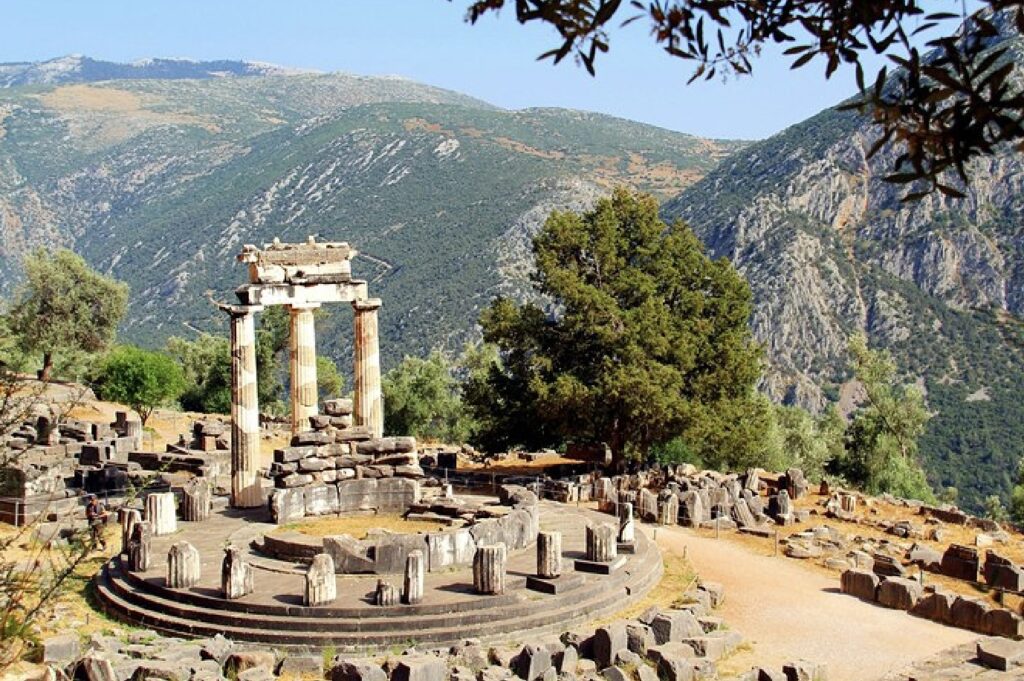
2. The Sacred Way
- This path leads up from the entrance of the sanctuary to the Temple of Apollo. Lined with the remnants of treasuries, statues, and monuments, it was the route taken by pilgrims coming to consult the oracle.
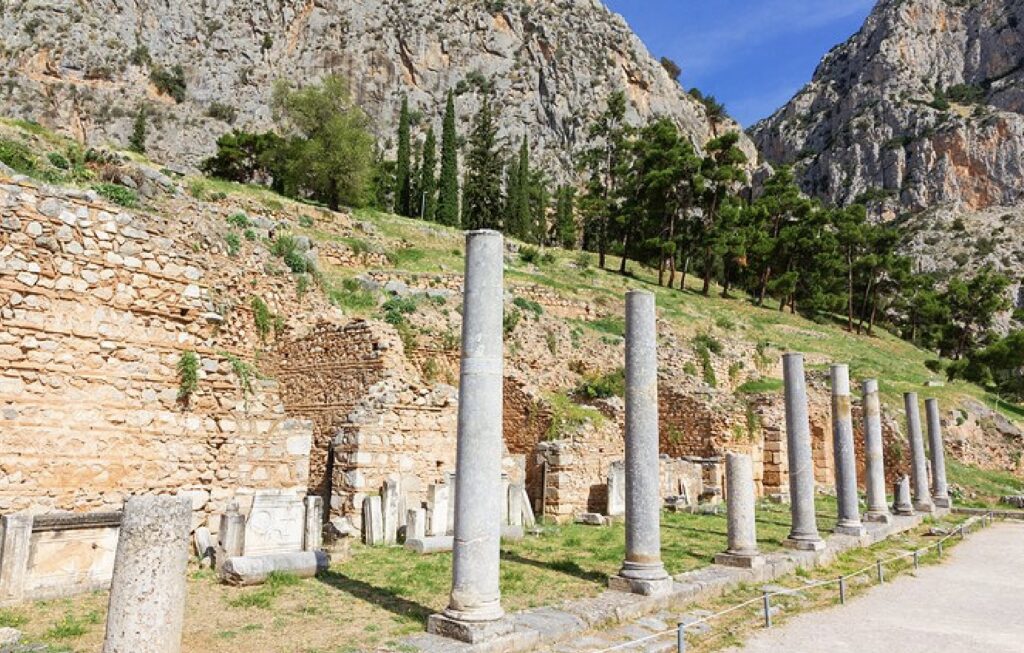
3. Treasury of the Athenians
- One of the best-preserved structures at Delphi, this small building was erected by the Athenians to house offerings to Apollo. It is adorned with detailed reliefs depicting scenes from Greek mythology.
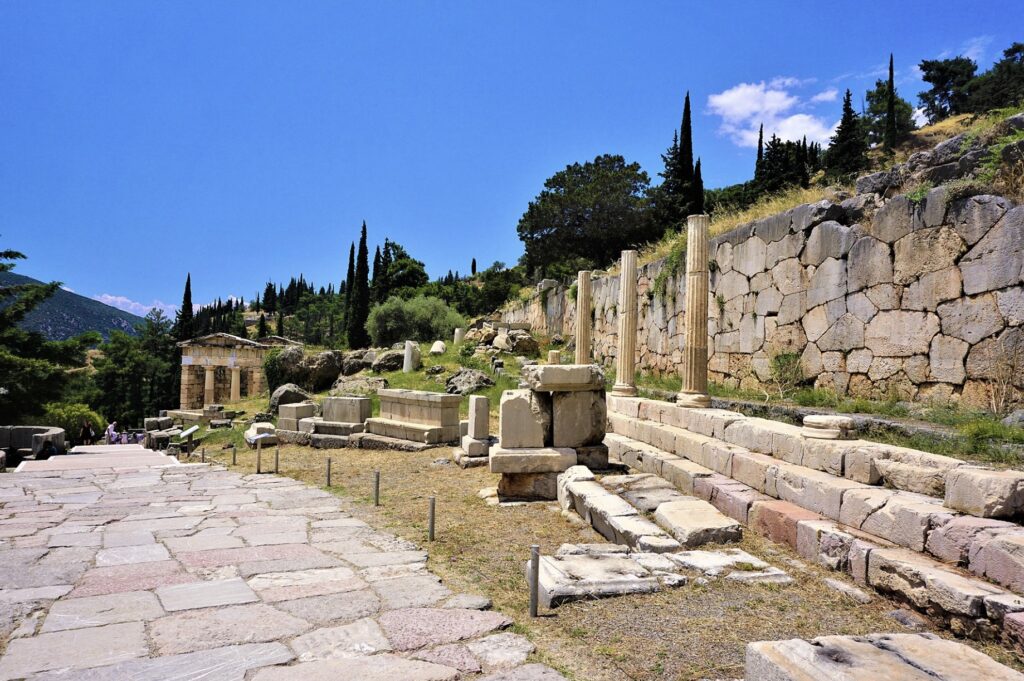
4. The Theatre of Delphi
- Located just above the Temple of Apollo, this ancient theatre could seat around 5,000 spectators. It was used for musical and theatrical performances, especially during the Pythian Games.
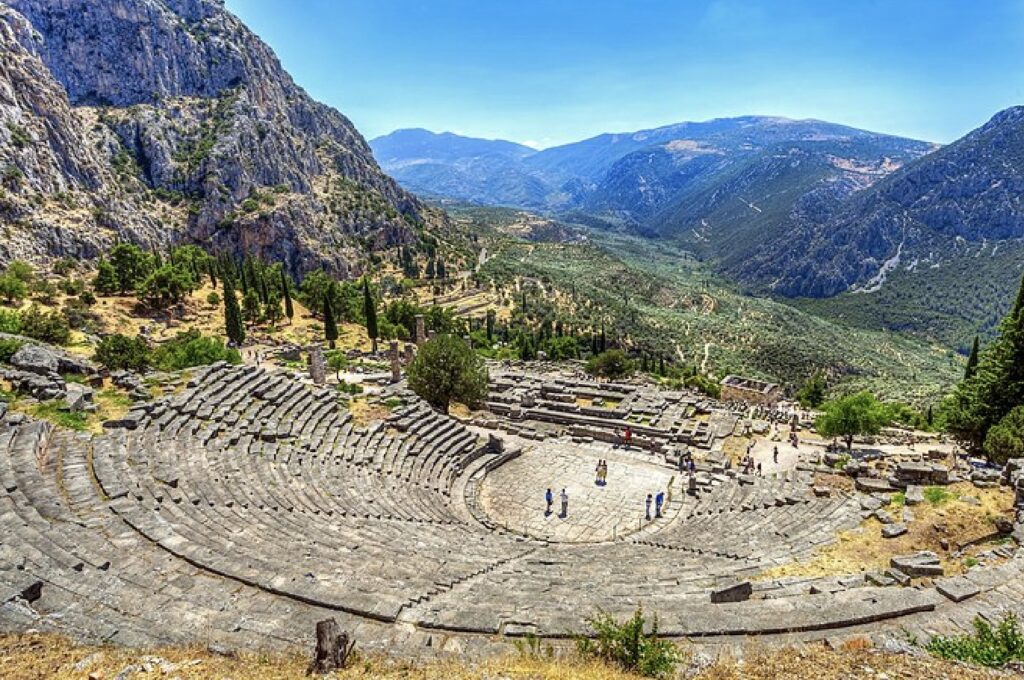
5. The Tholos of Delphi
- A circular building located in the sanctuary of Athena Pronaia, a short distance from the main complex. The Tholos is one of Delphi’s most iconic structures, characterized by its striking columns.
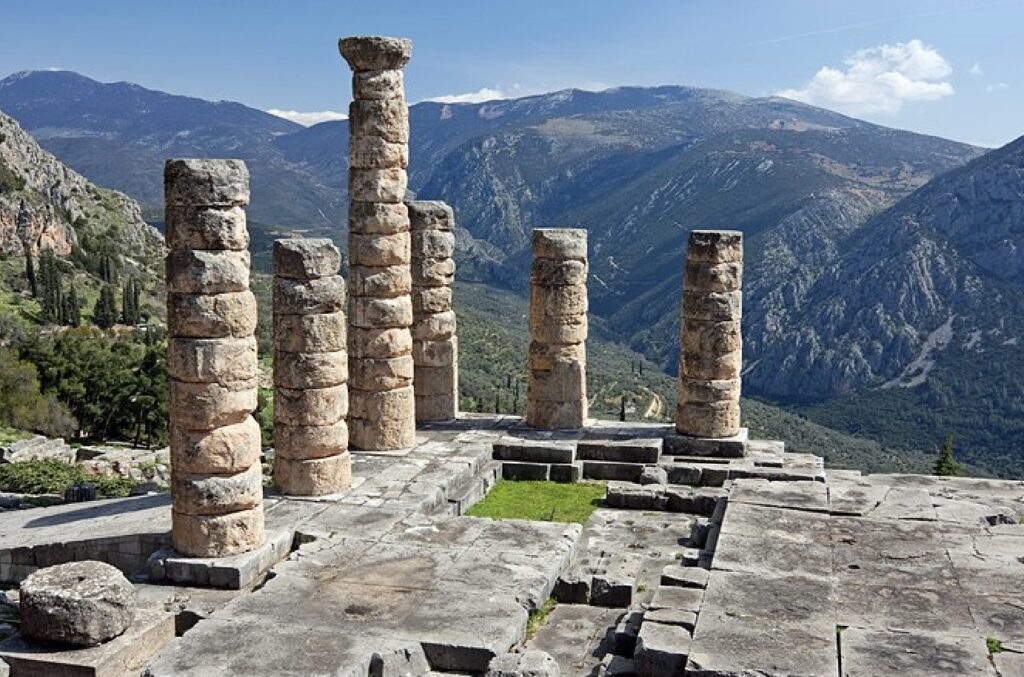
6. Stadium of Delphi
- Situated at the highest point of the site, the stadium hosted the athletic events of the Pythian Games. The stadium could accommodate around 6,500 spectators and features a well-preserved starting line.
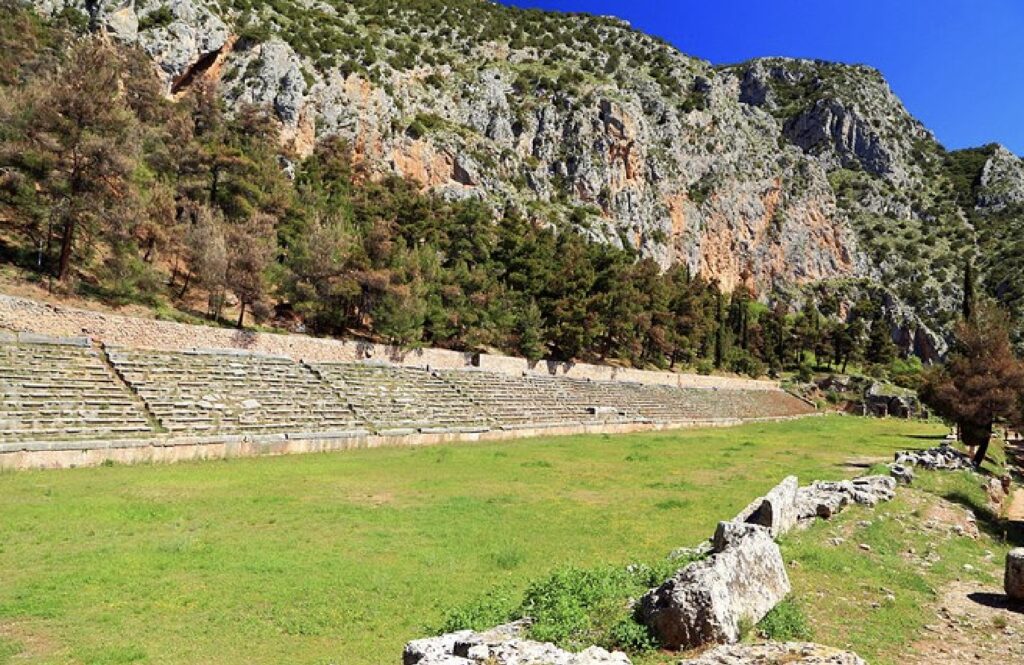
7. The Castalian Spring
- An ancient spring located on the way to the sanctuary, where pilgrims would purify themselves before consulting the oracle. The spring was also sacred to the Muses and Apollo.
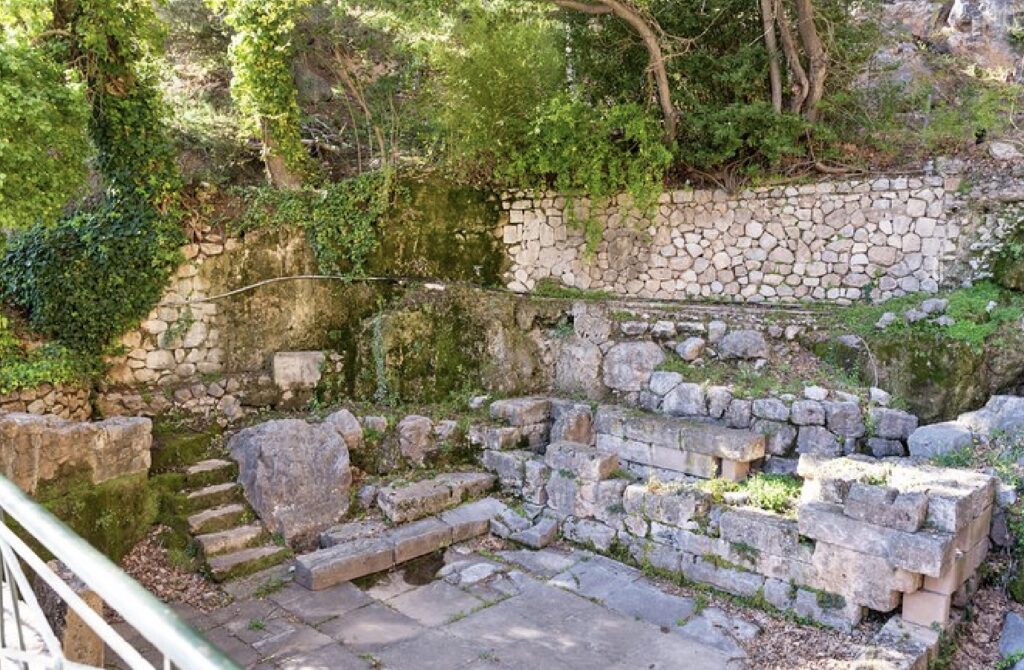
8. The Sibyl Rock
- A large rock near the Temple of Apollo where it is believed the Sibyl, an earlier prophetess of Delphi, would sit and deliver her oracles before the establishment of the Pythia.
9. The Polygonal Wall
- This retaining wall supports the terrace on which the Temple of Apollo stands. It is notable for its construction technique, using polygonal blocks of stone, and for the numerous inscriptions carved into it.
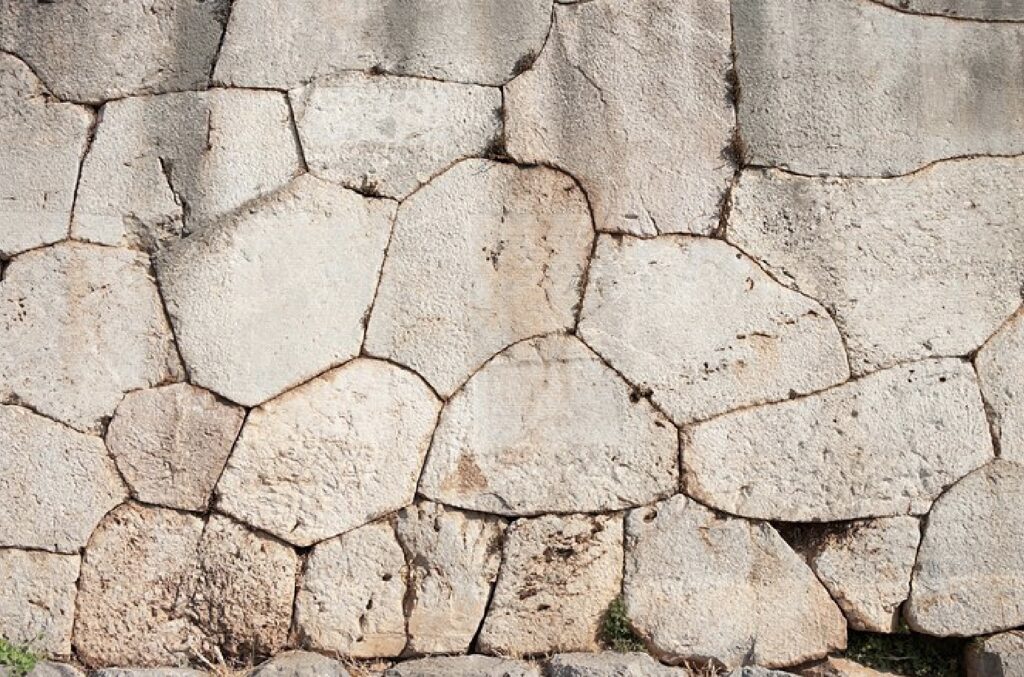
10. The Gymnasium
- A large complex located near the sanctuary of Athena Pronaia, it includes training areas, baths, and other facilities used by athletes competing in the Pythian Games.
11. Delphi Archaeological Museum
- This museum houses a vast collection of artifacts excavated from the site, including the famous Charioteer of Delphi, the Sphinx of Naxos, and the twin kouroi statues known as Kleobis and Biton.
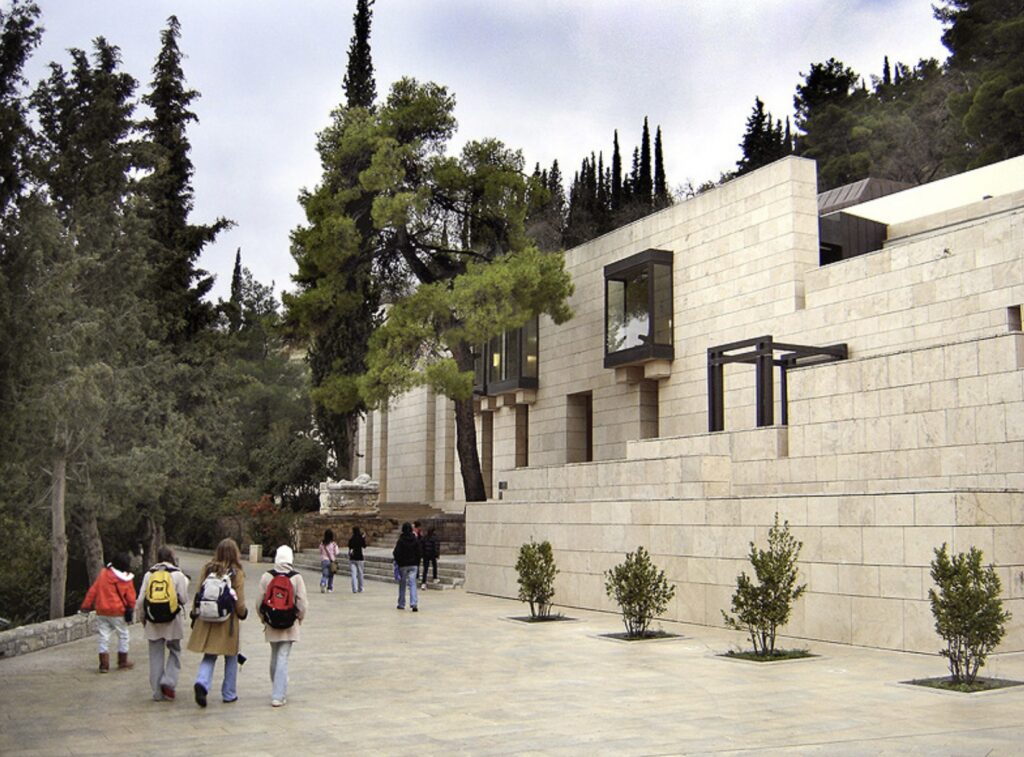
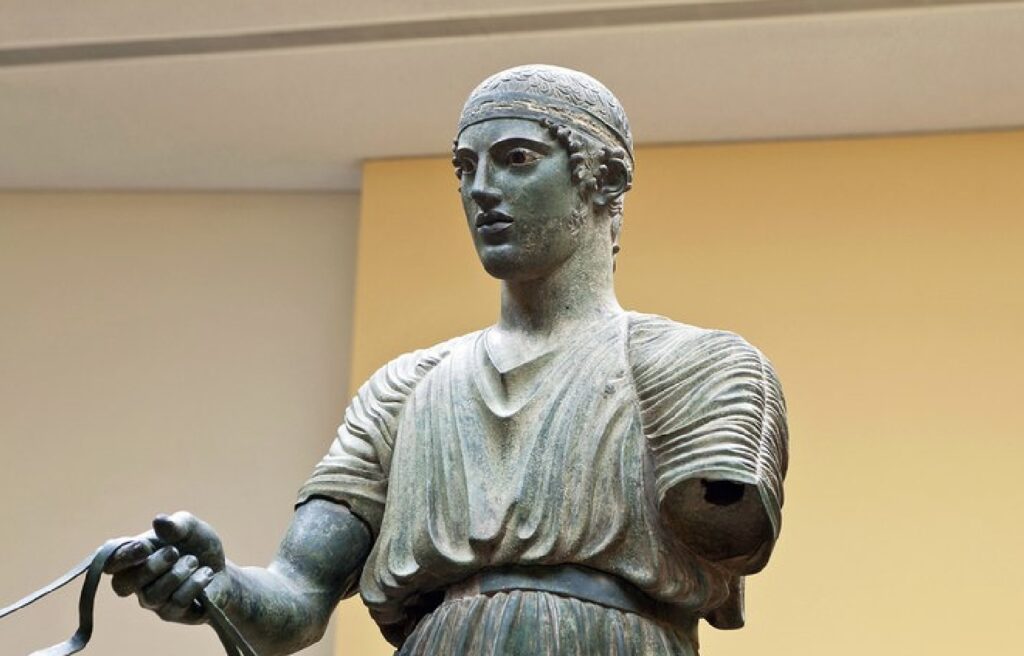
12. The Omphalos
- A symbolic stone representing the “navel” of the world, it is a key artifact associated with the mythological significance of Delphi. The original stone is in the Delphi Museum, while a replica can be seen at the site.
13. Sanctuary of Athena Pronaia
- Located just below the main sanctuary, this area includes the Tholos and two temples dedicated to Athena. The sanctuary served as a sort of prelude to the main sacred complex.
14. The Monument of the Plateans
- This monument commemorates the victory of the Greeks over the Persians at the Battle of Plataea in 479 BCE. It originally consisted of a bronze serpent column, with the surviving part now located in Istanbul.
15. Roman Agora
- A marketplace built during the Roman period, reflecting the continued importance of Delphi as a site even after the decline of the classical Greek world.
These monuments and attractions collectively provide a comprehensive view of Delphi’s historical, religious, and cultural significance, making it one of the most important archaeological sites in Greece.
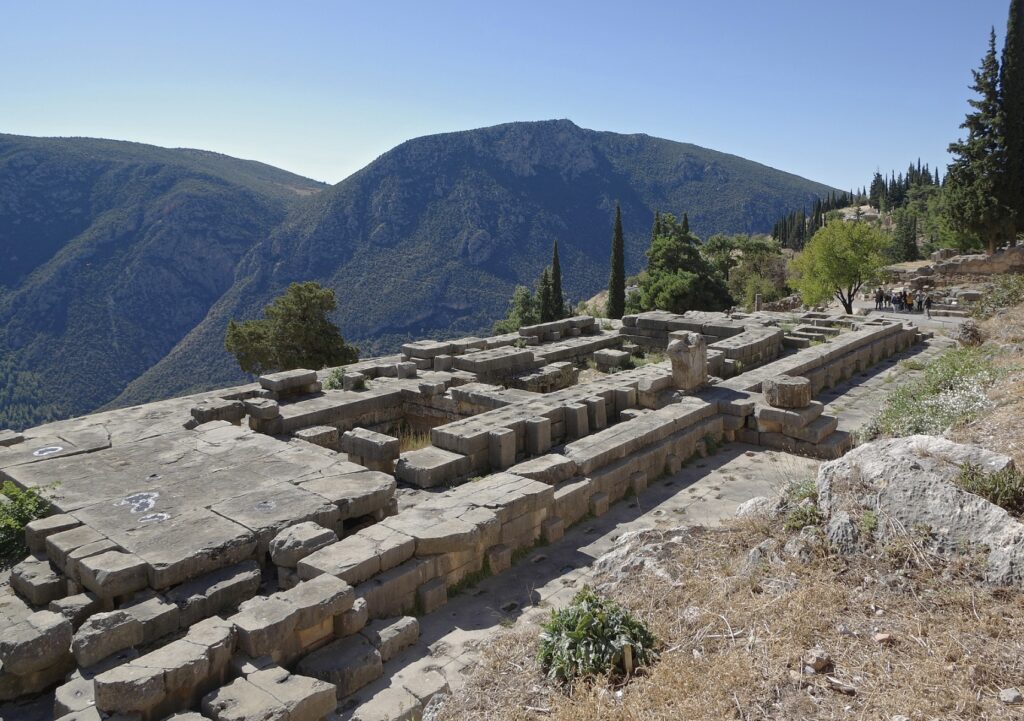
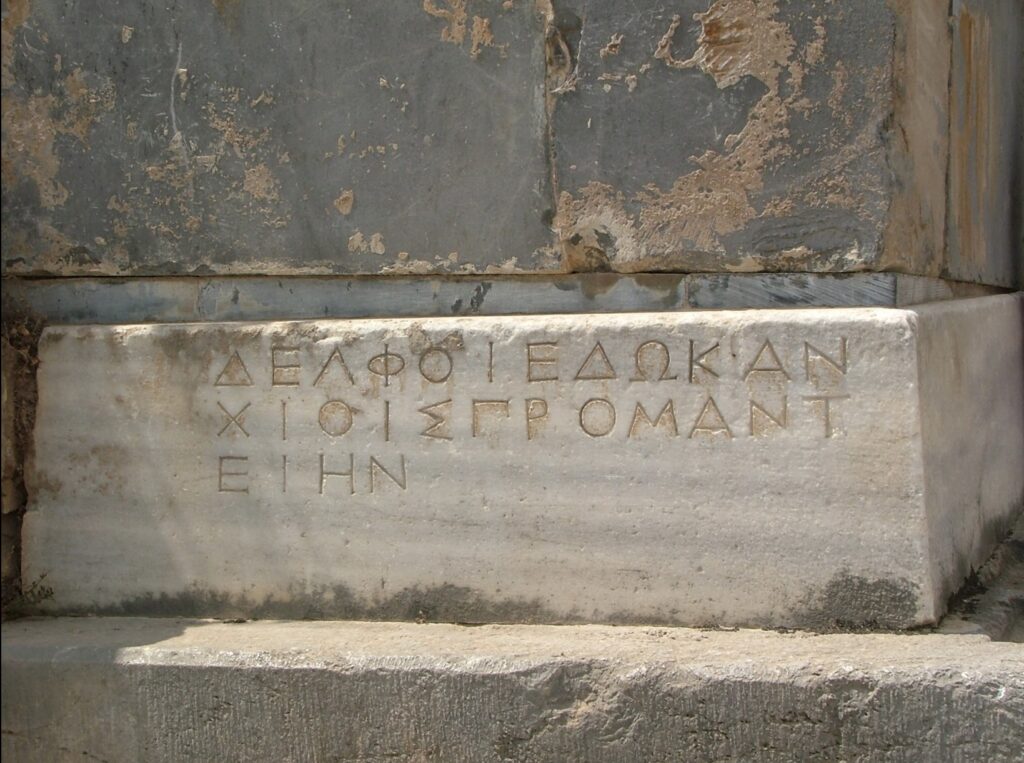
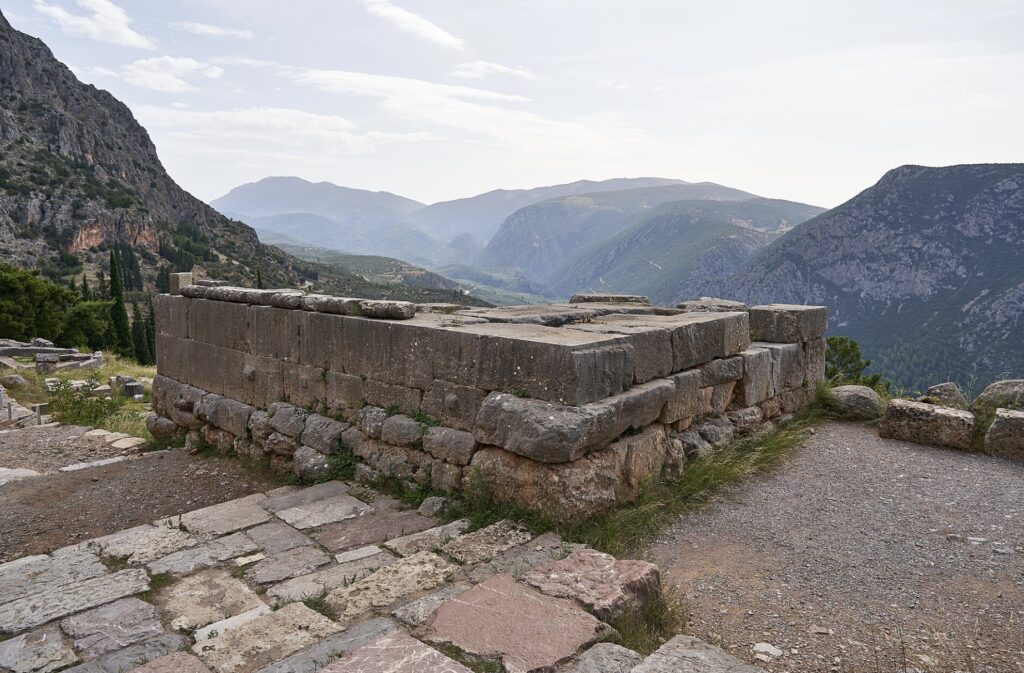
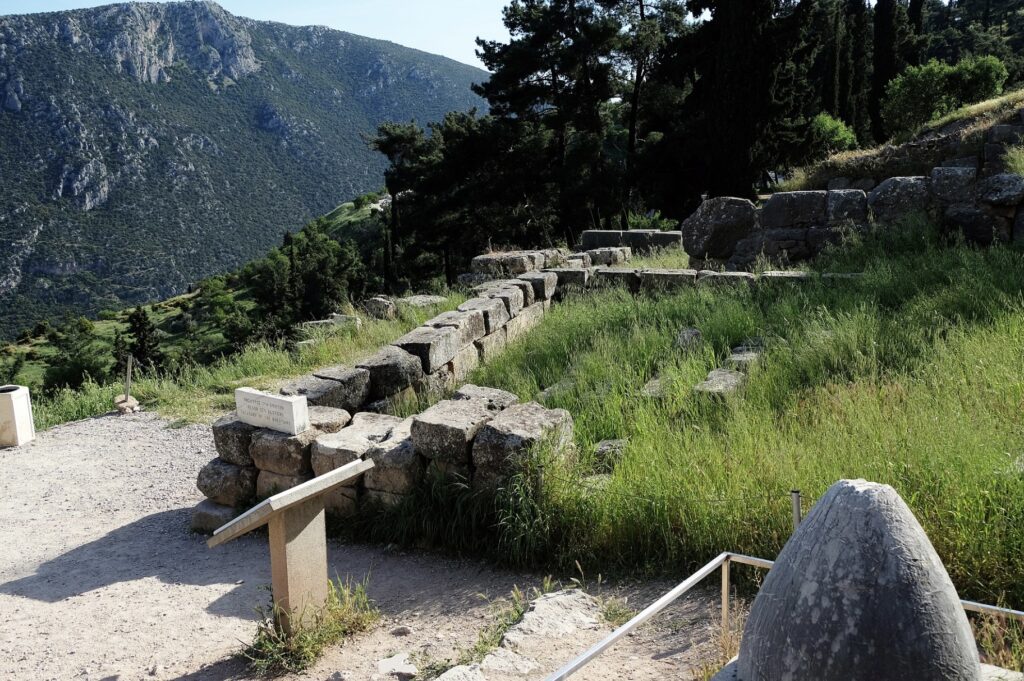
Here’s two-day itinerary for visiting Delphi:
Day 1: Arrival and Exploration
Morning:
- Arrival and Check-In:
- Arrive and check in at Kastalia Boutique Hotel, located in the heart of Delphi. Enjoy the elegant decor and relax on your balcony with panoramic views of the surrounding mountains and the Gulf of Corinth.
Late Morning:
- Explore the Sanctuary of Apollo:
- Begin your visit with the Temple of Apollo and walk along the Sacred Way. Explore the various treasuries, such as the Treasury of the Athenians, and appreciate the historical significance of the site.
- Continue to the Theatre of Delphi, where you can take in the expansive views of the site and the valley below.
Lunch:
- Lunch at Epikouros Taverna (Delphi):
- Enjoy lunch at Epikouros Taverna, a short walk from the site. The restaurant offers traditional Greek dishes with fresh local ingredients. Try their famous souvlaki or moussaka, accompanied by local wine.
Afternoon:
- Visit the Delphi Archaeological Museum:
- Spend the afternoon at the Delphi Archaeological Museum, exploring the rich collection of artifacts, including the Charioteer of Delphi, the Sphinx of Naxos, and other treasures that bring the ancient world to life.
- Sanctuary of Athena Pronaia:
- After the museum, head to the nearby Sanctuary of Athena Pronaia. Explore the Tholos and other ruins in this picturesque location, which served as a prelude to the main sanctuary.
Evening:
- Dinner at Taverna Vakhos (Delphi):
- For dinner, dine at Taverna Vakhos, known for its excellent traditional Greek cuisine and beautiful views over the valley. Enjoy dishes like lamb kleftiko or stuffed vine leaves.
Night:
- Return to Kastalia Boutique Hotel:
- Return to your hotel for a relaxing evening. Enjoy a nightcap on your balcony or unwind in the hotel’s stylish lounge area.
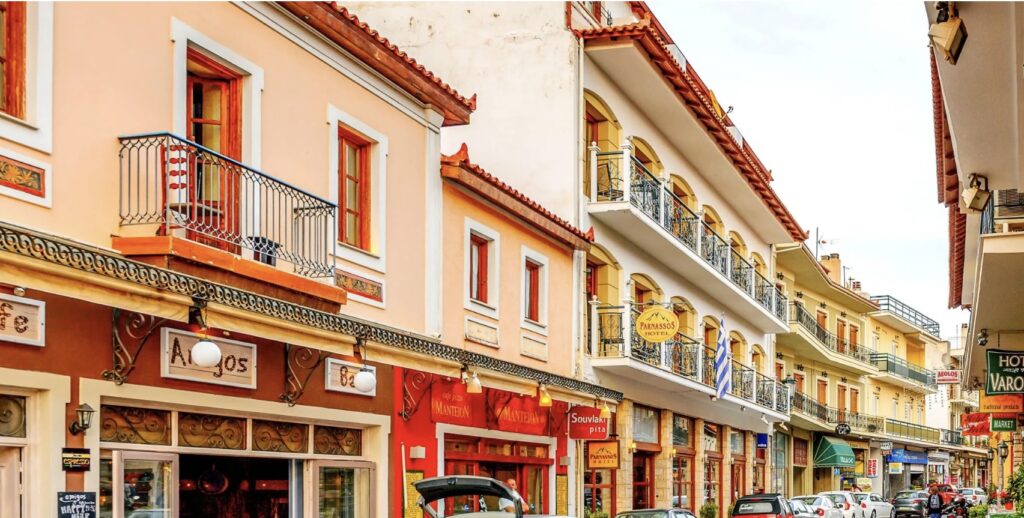

Day 2: Further Exploration and Local Experiences
Morning:
- Breakfast at the Hotel:
- Start your day with a delicious breakfast at Kastalia Boutique Hotel, featuring local specialties such as Greek yogurt, honey, and fresh pastries.
Late Morning:
- Hike to the Corycian Cave:
- After breakfast, embark on a morning hike to the Corycian Cave on Mount Parnassus. This cave, sacred to Pan and the Muses, offers stunning natural beauty and a peaceful retreat into nature.
Lunch:
- Lunch at Taverna To Patriko Mas (Delphi):
- After your hike, return to Delphi for lunch at Taverna To Patriko Mas. This cozy taverna serves hearty Greek dishes like gemista (stuffed tomatoes and peppers) and tzatziki with fresh bread.
Afternoon:
- Explore the Stadium and Gymnasium:
- Continue your exploration with a visit to the Stadium of Delphi, located at the top of the archaeological site. Then, head to the Gymnasium and the Castalian Spring to complete your tour of Delphi’s ancient sites.
Mid-Afternoon:
- Café Break at Symposium Café (Delphi):
- Enjoy a relaxing mid-afternoon break at Symposium Café. Indulge in a traditional Greek coffee or herbal tea with a sweet treat like baklava or loukoumades.
Evening:
- Dinner at Iniohos Restaurant (Delphi):
- For your final dinner, dine at Iniohos Restaurant, offering a mix of traditional and contemporary Greek cuisine. Try their seafood saganaki or pastitsio, paired with a selection of local wines.
Night:
- Final Night at Kastalia Boutique Hotel:
- Return to Kastalia Boutique Hotel for a final evening of relaxation. Enjoy the serene atmosphere of the hotel and perhaps a stroll through Delphi town before retiring for the night.
Additional Tips:
- Shopping: Don’t miss the opportunity to explore local shops in Delphi for unique souvenirs like olive oil, local honey, and handcrafted items.
- Guided Tour: Consider hiring a local guide for deeper insights into Delphi’s rich history and mythology.
This itinerary ensures that you experience the best of Delphi’s historical sites, natural beauty, luxurious accommodation, and local culinary delights, all while staying at the conveniently located Kastalia Boutique Hotel.
